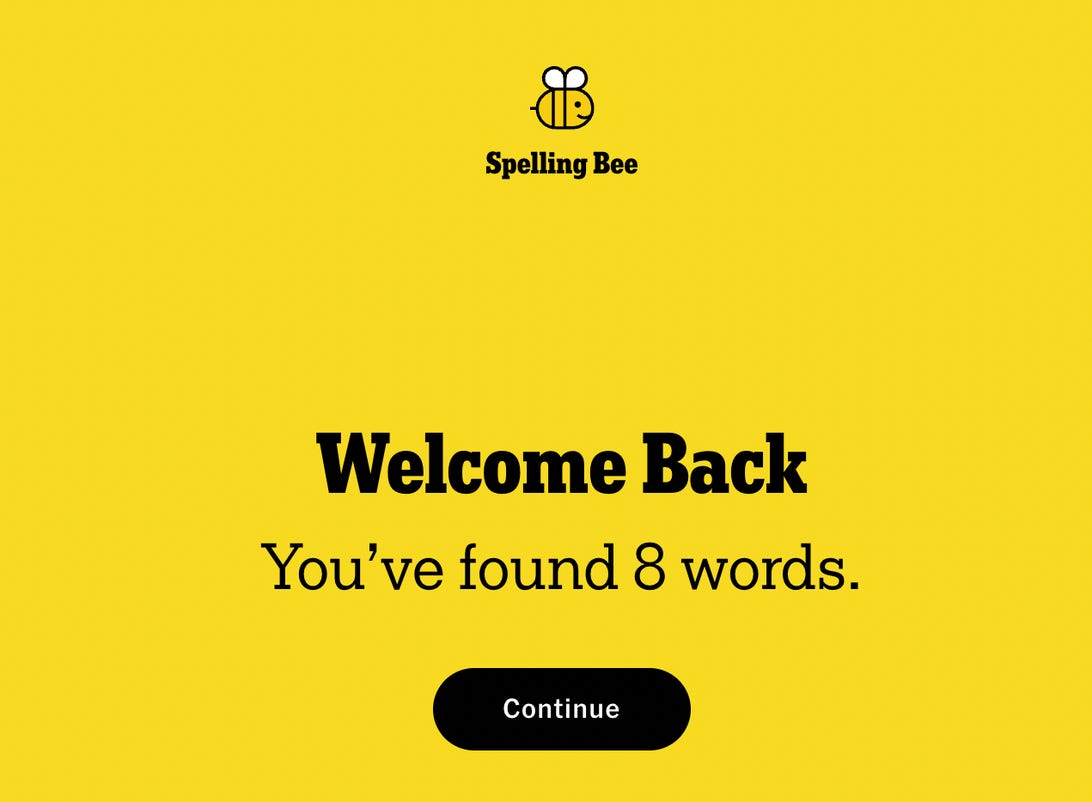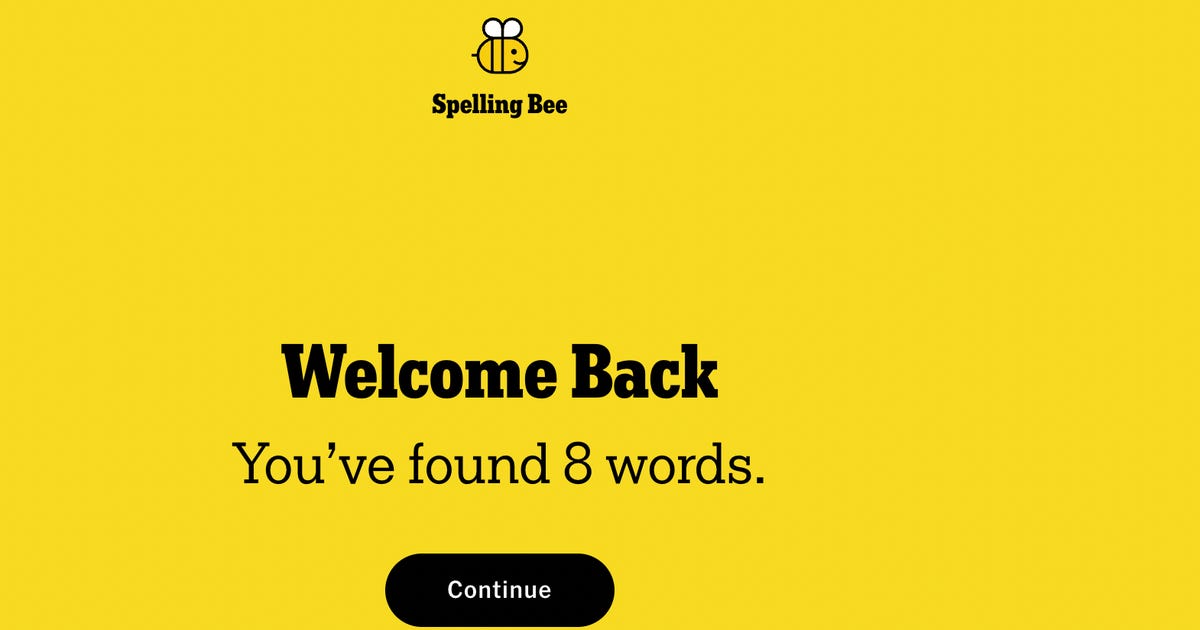New York Times Spelling Bee: 10 Tips and Strategies to Help You Win

The New York Times Spelling Bee might take longer than Wordle to complete, but it’s an intriguing challenge.
Screenshot by Gael Fashingbauer Cooper/CNET
The hot online game Wordle reignited many people’s love of word games. But Wordle is a quick game — you can only make six guesses and then you’re done, right or wrong. CNET has recommended a number of other online word games, but here’s my favorite after Wordle: The New York Times Spelling Bee.
The NYT Spelling Bee has been around since 2014 in print and since 2018 online. The rules are pretty simple: Each day offers up seven letters arranged in a honeycomb shape (honeycomb, spelling BEE, somebody on the Times design staff got a buzz out of that).
Players need to make words of four or more letters using the given letters, and always have to include the center letter. There’s always one pangram, which means a word that uses all seven of the letters and counts for big points. The game reminds me of a childhood favorite, Boggle, minus the little lettered dice and fun-to-shake game tray, but with all the setup and scoring done for me.
As you find words, the puzzle praises you with such compliments as “genius” or “amazing” and moves your score up a little line giving you higher ranks as you progress. If you find all the possible words, you’re rewarded with the title of “Queen Bee.” Or, uh, so I hear. I have yet to ever do that.
Can I play the Spelling Bee for free?
Note that while Wordle is free on the New York Times site — at least for now — the New York Times Spelling Bee is more complicated. Stay with me, here.
People who don’t subscribe to any form of the New York Times, paper or digital, can play up to the rank of “Solid,” a Times spokesperson told me in an email, noting that this may be a different number of words each day, depending upon the puzzle.
If you get the print version of the Times delivered, you have access to play the Spelling Bee daily. If you have a digital subscription, it depends on the pricing level you pay. Games, including the Spelling Bee, aren’t included in the cheapest subscription, the Basic level. But the next level up, All-Access, does include NYT Games. Those levels are explained here.
You can also choose to buy a NYT Games subscription, which costs $40 a year, or $1.25 a week, paid monthly. The newspaper is smart enough to know that some people just want its iconic crossword puzzle and other word games, including the Spelling Bee, and so lets people pay to do just that. You also have access to puzzle archives and a whole batch of other game goodies with this deal.
Want to play via an app? The Times Games app (called simply The New York Times Crossword) on iOS and Android is free to download for anyone, but only home delivery, All-Access and NYT Games subscribers have full access to everything the app offers, the spokesperson told me.
New York Times Spelling Bee tips, tricks and strategies
Just as with Wordle, there are some tips and strategies for playing the New York Times Spelling Bee. Here’s my best advice.
- Look for prefixes and suffixes
So you’ve made a word — say, “happy.” You’ll be even happier if you can turn that base word into a bunch more. If you have the right letters, use a prefix, like “unhappy,” or a suffix — “happiness.” There are levels of happy, too, like “happiest” or “happier.” No reason not to wring as much juice out of one word as possible.
2. -ING and -ED endings
If you ever see the letters ING or ED in your daily spelling bee, you’re golden. Maybe you found a word like “test,” as in “The New York Times Spelling Bee is a real test of my patience.” You can dress that up with “testing” or “tested.”
3. Share the load with a friend
CNET’s Connie Guglielmo shared this advice for the Bee in our Wordle tips story. She plays the Spelling Bee with her husband. One of them starts the game and finds as many words as they can. The Genius level requires 68 points, so one person works their way up to 34, then the other player takes over. Once they reach the Genius level, either one can chime in with more words in their attempt to reach the Queen Bee level. “In 18 months of playing, we’ve only gotten Queen Bee twice!” she says.
4. Remember that pangram
The puzzle promises that there is always one pangram — a word using all seven of the provided letters. Just knowing that word is out there sometimes pushes me to see the options. I’ll keep rearranging the letters to see if I’m inspired to find that magical word. Not that it could be longer than seven letters, if you reuse a letter or two. And once you have it, check to see if there are smaller words (minimum of four letters though) hidden inside that long word.
5. Check previous games for oddball words
You can go back and look at the previous day’s game — and you should. As Guglielmo points out, over time, you’ll learn that words you may never have thought of are included, such as “ratatatat.” CNET staffer Dan Avery, a frequent player, notes that just like with crossword puzzles, certain relatively obscure words show up again and again, such as “acai” and “acacia.”
6. Hit that reshuffle button often
The Spelling Bee has a super-simple layout. Below the day’s letters, there’s a button to delete letters from your guess and a button to enter, or submit, your guess. In-between those buttons is an unlabeled reshuffle button. This doesn’t give you new letters, but it does rearrange the day’s batch. Use that button, often. Getting different letters next to each other helps you start to see obvious words that you missed, Guglielmo points out.
7. Remember to reuse letters
Just like in Wordle, letters can be used more than once. As you study the honeycomb of letters, think about which ones are frequently doubled up in words (EE, RR, LL) and see if you can do that here.
8. Center letter strategies
Oof, that diabolical center letter. It has to be in every word you make, and many times I’ve thought I had a great answer, only to have my word rejected because I forgot the center letter. If you have a word rejected for this reason, consider if that word can be used in a compound word that might include the center letter.
9. Weird plurals
The puzzles never include the letter S, because then, almost every word players find could be made plural. But you can be on the lookout for plural forms of words that don’t include an S, like “teeth” and “children.”
10. More tips from the Times
The New York Times asked some of its dedicated Spelling Bee players to share their secrets and published the results. Their story points out online fan sites and forums, and relevant Twitter hashtags, all of which can be used to get daily help with the game.
Movies coming in 2022 from Marvel, Netflix, DC and more
See all photos
For all the latest world News Click Here

